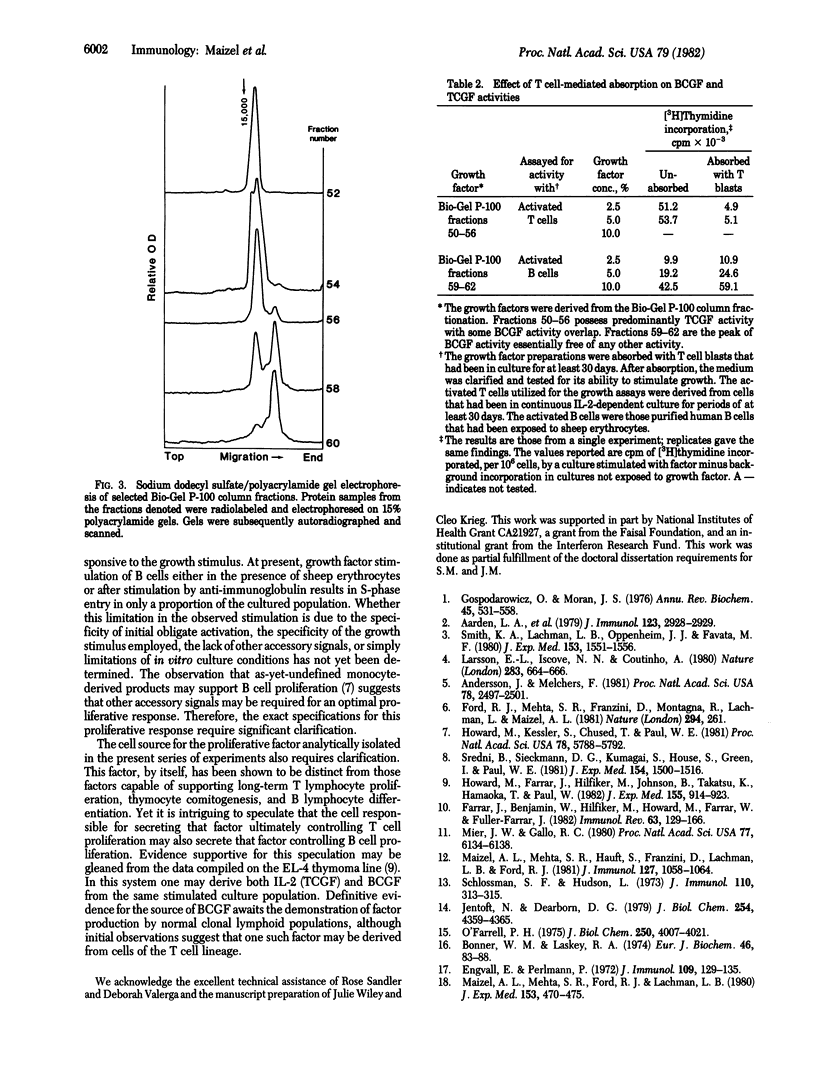Abstract
Recent studies have established the ability of human B lymphocytes to undergo G1-phase cell cycle progression and subsequent DNA synthesis upon exposure to factor(s) present in media conditioned by lectin-stimulated mononuclear cells. Procedures for the isolation of such a cytokine have been the focus of the present investigation. Conditioned medium from cells stimulated by lectin for 72 hr was fractionated by ammonium sulfate precipitation, ion-exchange chromatography, and gel filtration chromatography. During the isolation procedure the proliferation-stimulating activity of the column fractions was assayed concurrently on purified human T cells, purified human B cells, and murine thymocytes. T cell and B cell stimulatory factors present in the initial conditioned medium were found to copurify during ammonium sulfate precipitation, DEAE-Sephadex chromatography, and Bio-Gel P-30 gel filtration. However, partial separation of these two activities was achieved after Bio-Gel P-100 gel filtration. Analytic polyacrylamide gel electrophoresis of radiolabeled Bio-Gel P-100 column fractions demonstrated a distinct protein band of 14,000-15,000 daltons in those column fractions predominantly supporting T cell growth and a distinct protein band of 12,000-13,000 daltons for those fractions predominantly supporting B cell growth. The fractions associated with B cell mitogenic activity induced B cell S-phase entry in a proportion of B lymphocytes in the absence of any detectable IgM secretion.
Full text
PDF




Selected References
These references are in PubMed. This may not be the complete list of references from this article.
- Anderson J., Melchers F. T cell-dependent activation of resting B cells: requirement for both nonspecific unrestricted and antigen-specific Ia-restricted soluble factors. Proc Natl Acad Sci U S A. 1981 Apr;78(4):2497–2501. doi: 10.1073/pnas.78.4.2497. [DOI] [PMC free article] [PubMed] [Google Scholar]
- Bonner W. M., Laskey R. A. A film detection method for tritium-labelled proteins and nucleic acids in polyacrylamide gels. Eur J Biochem. 1974 Jul 1;46(1):83–88. doi: 10.1111/j.1432-1033.1974.tb03599.x. [DOI] [PubMed] [Google Scholar]
- Engvall E., Perlmann P. Enzyme-linked immunosorbent assay, Elisa. 3. Quantitation of specific antibodies by enzyme-labeled anti-immunoglobulin in antigen-coated tubes. J Immunol. 1972 Jul;109(1):129–135. [PubMed] [Google Scholar]
- Farrar J. J., Benjamin W. R., Hilfiker M. L., Howard M., Farrar W. L., Fuller-Farrar J. The biochemistry, biology, and role of interleukin 2 in the induction of cytotoxic T cell and antibody-forming B cell responses. Immunol Rev. 1982;63:129–166. doi: 10.1111/j.1600-065x.1982.tb00414.x. [DOI] [PubMed] [Google Scholar]
- Ford R. J., Mehta S. R., Franzini D., Montagna R., Lachman L. B., Maizel A. L. Soluble factor activation of human B lymphocytes. Nature. 1981 Nov 19;294(5838):261–263. doi: 10.1038/294261a0. [DOI] [PubMed] [Google Scholar]
- Gospodarowicz D., Moran J. S. Growth factors in mammalian cell culture. Annu Rev Biochem. 1976;45:531–558. doi: 10.1146/annurev.bi.45.070176.002531. [DOI] [PubMed] [Google Scholar]
- Howard M., Farrar J., Hilfiker M., Johnson B., Takatsu K., Hamaoka T., Paul W. E. Identification of a T cell-derived b cell growth factor distinct from interleukin 2. J Exp Med. 1982 Mar 1;155(3):914–923. doi: 10.1084/jem.155.3.914. [DOI] [PMC free article] [PubMed] [Google Scholar]
- Howard M., Kessler S., Chused T., Paul W. E. Long-term culture of normal mouse B lymphocytes. Proc Natl Acad Sci U S A. 1981 Sep;78(9):5788–5792. doi: 10.1073/pnas.78.9.5788. [DOI] [PMC free article] [PubMed] [Google Scholar]
- Jentoft N., Dearborn D. G. Labeling of proteins by reductive methylation using sodium cyanoborohydride. J Biol Chem. 1979 Jun 10;254(11):4359–4365. [PubMed] [Google Scholar]
- Larsson E. L., Iscove N. N., Coutinho A. Two distinct factors are required for induction of T-cell growth. Nature. 1980 Feb 14;283(5748):664–666. doi: 10.1038/283664a0. [DOI] [PubMed] [Google Scholar]
- Maizel A. L., Mehta S. R., Ford R. J., Lachman L. B. Effect of interleukin 1 on human thymocytes and purified human T cells. J Exp Med. 1981 Feb 1;153(2):470–475. doi: 10.1084/jem.153.2.470. [DOI] [PMC free article] [PubMed] [Google Scholar]
- Maizel A. L., Mehta S. R., Hauft S., Franzini D., Lachman L. B., Ford R. J. Human T lymphocyte/monocyte interaction in response to lectin: kinetics of entry into the S-phase. J Immunol. 1981 Sep;127(3):1058–1064. [PubMed] [Google Scholar]
- Mier J. W., Gallo R. C. Purification and some characteristics of human T-cell growth factor from phytohemagglutinin-stimulated lymphocyte-conditioned media. Proc Natl Acad Sci U S A. 1980 Oct;77(10):6134–6138. doi: 10.1073/pnas.77.10.6134. [DOI] [PMC free article] [PubMed] [Google Scholar]
- O'Farrell P. H. High resolution two-dimensional electrophoresis of proteins. J Biol Chem. 1975 May 25;250(10):4007–4021. [PMC free article] [PubMed] [Google Scholar]
- Schlossman S. F., Hudson L. Specific purification of lymphocyte populations on a digestible immunoabsorbent. J Immunol. 1973 Jan;110(1):313–319. [PubMed] [Google Scholar]
- Smith K. A., Lachman L. B., Oppenheim J. J., Favata M. F. The functional relationship of the interleukins. J Exp Med. 1980 Jun 1;151(6):1551–1556. doi: 10.1084/jem.151.6.1551. [DOI] [PMC free article] [PubMed] [Google Scholar]
- Sredni B., Sieckmann D. G., Kumagai S., House S., Green I., Paul W. E. Long-term culture and cloning of nontransformed human B lymphocytes. J Exp Med. 1981 Nov 1;154(5):1500–1516. doi: 10.1084/jem.154.5.1500. [DOI] [PMC free article] [PubMed] [Google Scholar]


